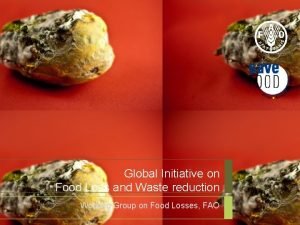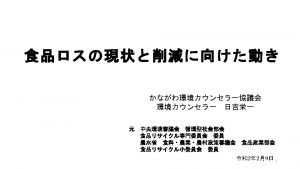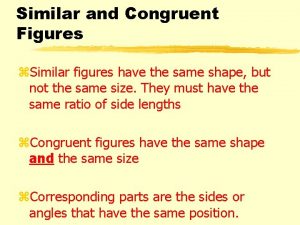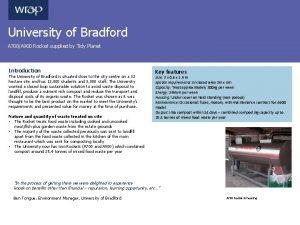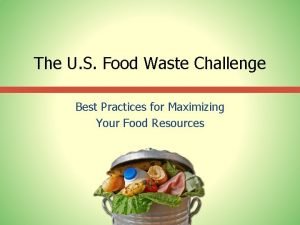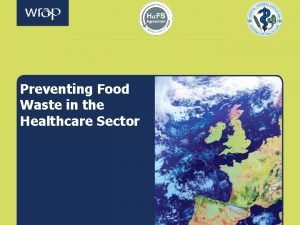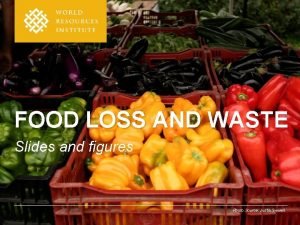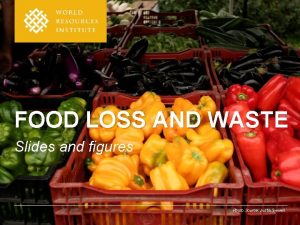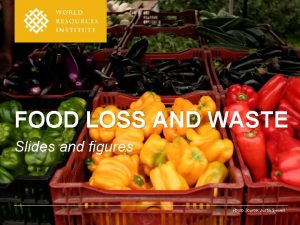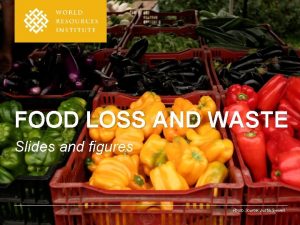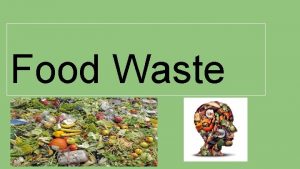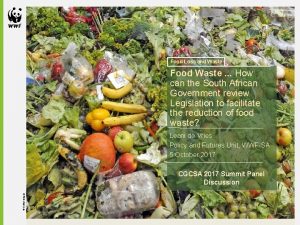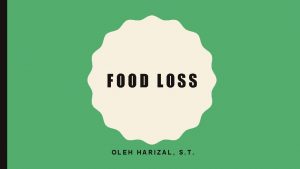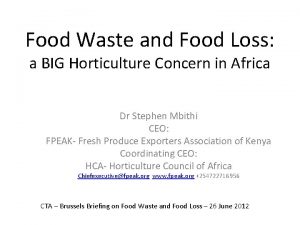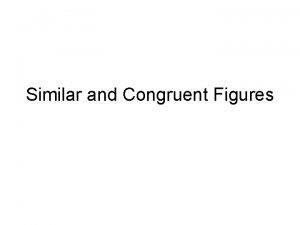FOOD LOSS AND WASTE Slides and figures Photo














- Slides: 14

FOOD LOSS AND WASTE Slides and figures Photo Source: Justin Sewell

A significant share of food intended for human consumption is lost or wasted from the farm to the fork 32% of global food supply by weight 24% of global food supply by energy content (calories) Source: WRI analysis based on FAO. 2011. Global food losses and food waste – extent, causes and prevention. Rome: UN FAO.

Food is lost or wasted along the entire value chain During or immediately after harvesting on the farm After leaving the farm for handling, storage, and transport During industrial or domestic processing and/or packaging During distribution to markets, including at wholesale and retail markets Source: WRI analysis based on FAO. 2011. Global food losses and food waste – extent, causes and prevention. Rome: UN FAO. In the home or business of the consumer, including restaurants and caterers

Food loss and waste occurs more ‘near the fork’ in developed regions and more ‘near the farm’ in developing regions 100% = 1. 5 quadrillion kcal Source: WRI analysis based on FAO. 2011. Global food losses and food waste – extent, causes and prevention. Rome: UN FAO.

Losses at production are more prevalent in developing regions while food waste at consumption is more prevalent in developed regions (Percent of kcal lost and wasted) Note: Number may not sum to 100 due to rounding. Source: WRI analysis based on FAO. 2011. Global food losses and food waste – extent, causes and prevention. Rome: UN FAO.

Cereals comprise the most loss and waste when measured by calories, while fruits and vegetables by weight Source: WRI analysis based on FAO. 2011. Global food losses and food waste—extent, causes and prevention. Rome: UN FAO.


TARGET 12. 3 By 2030, halve per capita global food waste at the retail and consumer levels and reduce food losses along production and supply chains, including post-harvest losses

Champions 12. 3 is a unique coalition of leaders dedicated to inspiring ambition, mobilizing action, and accelerating progress toward achieving SDG Target 12. 3

MEMBERS Hans Hoogeveen Dave Lewis Ambassador and Permanent CEO Representative of the Netherlands to Tesco UN Organizations for Food and Agriculture Chair, Champions 12. 3 Inger Andersen Executive Director UN Environment Lindiwe Majele Sibanda Co-Chair Global Alliance for Climate Smart Agriculture Sunny Verghese CEO and Co-Founder Olam International Steven Cahillane CEO Kellogg Company Selina Juul Founder Stop Wasting Food Wai-Chan Managing Director The Consumer Goods Forum Paul Bulcke Chairman Nestlé S. A. Liz Goodwin Senior Fellow and Director, Food Loss and Waste World Resources Institute Co- Chair, Champions 12. 3 Oyun Sanjaasuren Director of External Affairs Green Climate Fund Theo De Jager President World Farmers’ Organisation Shenggen Fan Chair Professor China Agricultural University Feike Sijbesma Honorary Chairman Royal DSM Yolanda Kakabadse Member WWF US Board of Directors Sam Kass Former White House Chef, Founder, TROVE Venture Partner, Acre Venture Partners Josefa Leonel Correa Sacko Nguyen Xuan Cuong Commissioner for Rural Minister Economy and Agriculture Ministry of African Union Agriculture and Rural Development, Vietnam Louise Fresco Peter Bakker President, Executive Board President Wageningen University World Business Council for & Research Sustainable Development Michael La Cour Managing Director IKEA Food Services AB Mogens Jensen Minister for Food, Fisheries and Equal Opportunities Denmark Kevin Fay Executive Director Global Food Cold Chain Council Marcus Gover Chief Executive WRAP Esben Lunde Larsen Fellow World Resources Institute Rajiv Shah President Rockefeller Foundation Gilbert F. Houngbo President International Fund for Agricultural Development Juergen Voegele Vice President, Sustainable Development World Bank Alan Jope CEO Unilever Sadiq Khan Mayor London, UK Achim Steiner Administrator UNDP Stella Kyriakides Commissioner for Health and Food Safety European Commission Wiebe Dreijer Chairman of the Managing Board Rabobank Denis Machuel CEO Sodexo Andrew Steer President and CEO World Resources Institute Tristram Stuart Co-Founder Feedback Johann Swinnen Director General IFPRI

What Champions do Dedicate to SDG Target 12. 3 Lead by example Showcase successes Advocate for enabling conditions Achieve concrete results

Possible approaches for reducing food loss and waste NOT EXHAUSTIVE (not exhaustive) During or immediately after harvesting on the farm After leaving the farm for handling, storage, and transport During industrial or domestic processing and/or packaging Provide information on how to use unmarketable crops Improve storage technologies (e. g. , evaporative coolers, storage bags, metal silos, crates) Improve agriculture extension services During distribution to markets, including at wholesale and retail markets In the home or business of the consumer, including restaurants and caterers Re-engineer manufacturing processes Facilitate increased donation of unsold goods Conduct consumer education campaigns Introduce low-carbon cold chains Improve supply chain management Provide guidance on food storage and preparation to consumers Improve consumer cooking skills Improve access to infrastructure and markets Improve handling Improve packaging to keep food fresher for longer and optimize portion size Change food date labeling practices Reduce portion sizes Improve harvesting techniques Improve infrastructure (e. g. , roads) Change in-store promotions Eat “ugly” produce

Source: Re. FED. 2016. A Roadmap to Reduce U. S. Food Waste by 20 Percent.

United States Source: Re. FED. 2016. A Roadmap to Reduce U. S. Food Waste by 20 Percent.
 Food loss and waste
Food loss and waste Food loss and waste
Food loss and waste Difference between normal loss and abnormal loss
Difference between normal loss and abnormal loss A small child slides down the four frictionless slides
A small child slides down the four frictionless slides Starting from rest a marble first rolls down
Starting from rest a marble first rolls down Two shapes that are similar are also congruent
Two shapes that are similar are also congruent Plane shape
Plane shape Washing machine solid or plane figure
Washing machine solid or plane figure Unit 2 food food food
Unit 2 food food food Sequence of food chain
Sequence of food chain Food waste bradford
Food waste bradford 二戰英文
二戰英文 Food waste management software
Food waste management software Wars involving us
Wars involving us Food waste management system
Food waste management system
